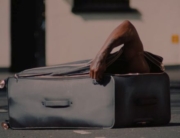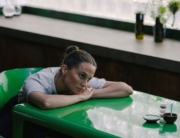How best to blend fantasy and reality, or make the fantastical compelling on screen, remains a challenge that has excited the minds of a variety of artists, with wildly different results. Ali Abassi’s Border (2018) is, perhaps, a seamless blend of the quotidian and the otherworldly, whereas in the world of director Guy Maddin, everything is a little nuts, yet it’s all of a piece in a fully realized world.
Kentucker Audley and Albert Birney’s Strawberry Mansion is firmly in the school where it’s all pretty wacky from the outset: James Prebel (Audley) finds himself in a sickeningly all-pink room where a man barges in offering him fast-food fried chicken. Alex then awakes from this dream and heads to work. He drives into the country and comes upon an almost too picturesque red house (the “strawberry mansion” of the title) at the top of a Technicolor-green hill. Here he meets Bella Isadora (Penny Fuller), who insists he lick an ice cream cone before he enters. His task is to audit her dreams.
This film takes place in a future (2035, to be exact) where the government records and taxes the dreams of its citizens. Bella has not recorded her dreams on the government-mandated, iPad–like device that Prebel uses. Instead, her house is full of VHS tapes, which make Prebel’s task especially laborious. She also, predictably, owes the government money, and as soon as Prebel starts to view her dreams, prices pop up on his screen next to animals, buildings, meals, and the like.
Bella herself seems more than agreeable. She invites Prebel to eat with her, gives him a spare room in which to stay (which he shares with a turtle named Sugarbaby), and is much more eager to chat than he is. Quickly, his experience of auditing her dreams unsettles him. First of all, he falls in love with the younger version of Bella (Grace Glowicki), and he starts to notice some odd things. Why does the bucket of chicken from his dream follow him into Bella’s dreams? And why does a fly issue warnings to him from the corner of the bedroom? Soon, he finds himself in a world of intrigue, pitted against the government, as he traverses the mind-bending landscape of dreams.
Strawberry Mansion seems like a lost relic of the early to mid-2000s, when Wes Anderson’s popularity was in full swing and films like Eternal Sunshine of the Spotless Mind, The Science of Sleep, and Garden State were the rage. The special effects are agreeably lo-fi, each detail is deliberately quirky, and the writers reach for both oddness and poignance at once. Prebel, with his neat mustache and brown suit, looks like a figure from an indie band of the time, and Bella the elder comes across as an octogenarian manic pixie dream girl. The color palette is not unlike Amelie, or the album art for an Animal Collective album.
Ultimately, this film feels like one for kids, in the worst possible sense, since it is half-baked, full of shallow caricatures and clichéd turns of plot. One of the most prominent reasons why it does not land is that the world of dreams is not much kookier than the real world, hence nothing in the dreams feels especially surprising. Yet one wonders if they would have any enchantment at all even if set against a more banal waking life. For instance, the giant talking mice, which Prebel encounters on board a dream ship, don’t have much to say for themselves. The acting is also not done any favors by the writing, and is often painfully transparent.
While it may outwardly harken back to indie films of a vanished decade, it reminded me much more of Barney in Outer Space.







Leave A Comment